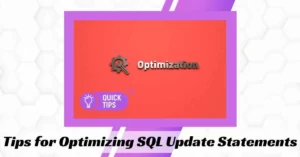Table of Contents
ToggleOverview
This Query for Update in SQL in existing data in a table is constructed to perform a desired action on the records that are set by certain conditions. The UPDATE statement in SQL can modify one or more existing field values, where the condition is specified. This query for update in SQL enables you to modify multiple rows at a time and to update values from other tables based on specified criteria. For example, it could be used to update multiple customer records with new information or to create new entries within the table using values from another table.
Additionally, complex logic within an UPDATE statement could be written into this query for update in SQL which would enable widespread changes with minimal effort on behalf of the user. Finally, this task can also access system variables providing dynamic updates when necessary such as timestamps within each entry being updated or working with unique IDs per record.
Objectives:
The purpose of using a query for update in SQL is to ensure accuracy when making changes to your data quickly and efficiently. By using an query for update in SQL you are able to make changes to multiple rows at once without having to manually enter each individual value again. This makes it easier to keep track of your data without wasting time entering duplicate information into separate tables or databases.
Update Operation:
The Update Operation allows a user to modify or delete existing records from a table or database. It also allows a user to insert new records into the system as well as alter existing ones by changing their values or attributes. The syntax required depends on the type of SQL being used but typically includes three parts; a start point clause, a set clause and an optional where clause which allows users to select specific records that will be modified with the rest of the command.
SQL Syntax:
UPDATE table_name
SET column1 = value1, column2 = value2, …
WHERE condition;
For example, let’s say we have a users table with name, email address and age columns and we’d like to update all user records that have an age greater than 18 years old by setting their email address as verified:
UPDATE User SET EmailVerified= “Yes” WHERE Age > 18;
If no WHERE clause were provided then ALL user records would receive an EmailVerified value of “Yes” regardless of their age. The syntax for this query would look like this:
UPDATE User SET EmailVerified=’Yes’;
To Learn in a Descriptive way: Best SQL Program in India
Types of Updates
Updating your data sets can be a tedious and time consuming task. Fortunately, with the right query for update in SQL, you can simplify this process and make it much easier to modify large data sets quickly and efficiently. Here, we will discuss the different types of updates available, common language used for query for update in SQL useful examples of updating data sets, syntax and structure of query for update in SQL, how to set conditions to specify which rows should be updated, benefits of using a query for update in SQL over manual changes, and potential issues arising from incorrect use of a query for update in SQL.
When it comes to updating data sets in databases using SQL, there are two different types of updates:
1. Single Table Updates
Single Table updates are used to modify existing records in a specific table of a database.
2. Multi Table Updates
Multi Table updates are used when it is necessary to update records across multiple tables in the same database.
The syntax for both types is nearly identical; however the underlying logic can sometimes differ depending on the particular needs of your application.
The language commonly used query for update in SQL (Structured Query Language). This language provides a variety of ways to express statements that modify or delete existing records from a relational database table. For example, if you wanted to add an additional record or change an existing one within a table named “customers” you could use the following statement:
UPDATE customers SET columnname = value WHERE condition;
In this statement, “columnname” represents the name of the column whose value is being edited, “value” represents the new value that will be assigned to that column name, and “condition” represents any additional conditions such as limiting.
Syntax of the Update Statement

The UPDATE statement is an essential part of working with SQL databases. It allows you to alter existing data and manipulate the contents of a table. In order for an UPDATE statement to work properly, it has to follow a set syntax structure. Knowing this syntax can help you query your database more efficiently.
A basic statement contains a Query for update in SQL, an Update Statement, and an Expression Rule. The Query section identifies the target column or columns that are being updated. The Update Statement will specify how the columns should be altered; it can include SET type instructions that define which value should be placed in each column as well as DELETE instructions if data needs to be removed. The Expression Rules section puts limits on which rows of data are to be modified; if there isn’t any limit specified then all rows will be updated by default.
You can further refine your query by adding a WHERE clause and/or ORDER BY clause. The WHERE clause defines additional criteria the data must meet before they can be updated; this could be something such as only updating records from a certain year or from a certain region etc. You can also use the ORDER BY clause to arrange the data before updating it; this helps prevent errors when large amounts of data are contained in multiple rows and columns. Finally, you have the SELECT option which allows you to test before executing the query; it returns only those records that would otherwise be changed by the UPDATE statement so you can doublecheck them first before making any changes.
Related Topics: Triggers in SQL with Examples
Queries Used to Filter Records

If you are looking to filter records in a database, queries are the best way to go. Writing queries allows you to take control of the records that your queries process and gives you all the data you need. Queries can be used to update, delete, insert, and select records from a database.
One simple way to narrow your search for records is by using filters. Filters allow you to specify which records should be selected and which ones should be excluded from the query results. To do this effectively, you can use SQL’s WHERE clause. This clause allows you to specify criteria that must be met in order for a record to be included in the result set. You can also use the ORDER BY clause if it is necessary for you to sort your results by one or more columns within the table.
In order to execute a query, you will need to use SQL’s SELECT statement followed by whatever data fields that need to be fetched from the table specified in the FROM clause. In addition, if desired, you can add a LIMIT clause at the end of your query so that it only retrieves a certain number of rows from your result set.
The power of
writing queries lies in querying databases quickly and efficiently without having to work through countless lines of code manually. Knowing how and when each part of the query should be used will help ensure accurate and efficient results every time.
Examples of Updating in SQL
Are you looking to understand how to update a database table in SQL? Updating your data is an important part of managing a database and it’s worth understanding the basics. This blog will cover the syntax, clauses, and various techniques used to update data in SQL.
You can create an update query to modify existing data rows in a database table. The syntax for creating this query follows a similar pattern for most database systems:
Update
SET =
WHERE ;
The SET clause defines the column name and value to be updated, while the WHERE clause defines the criteria for which records should be affected when executing this query. You can also use expressions and functions within your Query for Update in SQL in order to modify multiple columns at once or perform calculations on numerical values.
You can also join tables within an Query for Update in SQL if you need to reference related data between two or more sources. This allows you to use fields from other tables as part of your criteria for updating records. Additionally, you can use subqueries as part of the SET claused when performing Query for Update in SQL allowing you to base values on the output of a separate query.
By understanding updating basics in SQL, you will be able to effectively manage your databases and ensure that all information is uptodate and accurate. Having strong familiarity with Query for Update in SQL, will enable you to quickly modify your databases as necessary and keep them organized with ease.
Joining Tables to Update Information

For database developers and users, having the ability to join tables to update information is an integral part of working with data. Whether you’re writing queries in SQL or running commands in a database language, knowing how to join tables for updating information is essential for any database user.
A query is a statement that you issue to the database in order to retrieve or alter data. Joining tables allows you to connect two or more tables together and use them together in a query. This means that when you join tables, all of the related data from each table can be used at once, enabling you to accurately update multiple pieces of information at once.
When joining tables it’s important to identify the relationships between them so that the correct results can be returned when a query is issued. With this knowledge, you can write queries that will accurately update all related records across multiple tables with one command. Knowing how these relationships work is key when writing queries and joins are often needed as part of an UPDATE statement which alters existing data within a table or databases.
The INSERT statement is what inserts new records into a table while the UPDATE statement updates existing records with new values. Both queries are comprised of clauses and conditions which specify how exactly the query should behave when run on the database. For example, if you want to update specific records within a table depending on certain criteria, you need to specify these conditions in the WHERE clause. By understanding which clauses are required and how they work, it becomes easier for developers to write better queries which accurately update information without causing errors or corrupting data within your databases.
Resolving Problems with Updating Queries
If you’re looking to query for update in SQL, it’s important to understand the syntax and troubleshoot any errors that arise. To effectively query for update in SQL, it is often necessary to analyze the code for areas of improvement and optimize it for better performance. Understanding query syntax and the potential areas of improvement can help limit downtime when updating queries, as well as minimize any impact to users.
When you get a query for update in SQL, it is essential to start by understanding the syntax. This includes reading through the code and making sure your changes are accurate. Once a query has been identified for updating, reviewing it step by step will ensure that everything is accurate and up to date. Additionally, analyzing the code can uncover any potential areas of improvement that can be addressed. Implementing these changes can result in more efficient performance and improved overall results.
It is also important to think proactively when query for update in SQL. Scheduling Query for Update in SQL at off peak hours can help minimize any disruptions that may be caused by the change and ensure users have an uninterrupted experience. Additionally, monitoring activities after an Query for Update in SQL occurs will ensure accuracy, reduce help desk requests, and prevent potential issues from surfacing in the future.
Overall, implementing best practices for query for update in SQL can help streamline processes and increase efficiency. Taking time to understand query syntax and analyzing code for potential improvements is key for successful updates. Additionally, limiting downtime by scheduling updates during off peak hours and monitoring activities afterwards helps prevent user disruption while ensuring accuracy of updates. With these measures in place, you can ensure smoother query for update in SQL with minimal impact to users.
Also Read: SQL Practice Questions
Tips for Optimizing SQL Update Statements

Writing SQL UPDATE statements can be challenging and optimizing them for improved performance is of utmost importance. To help you get the most out of your queries, here are a few tips to help you optimize your SQL UPDATE statements.
Identifying Target Tables: To begin, you need to identify the target tables or table columns that you want to update. Once identified, you can then determine the best conditions to limit the number of rows affected by the query.
Limiting with Conditions: When limiting with conditions, it’s important to include criteria to reduce the number of affected rows. This will also prevent unintended data overwritten and maintain data integrity.
Using Indexes: Create an index on those columns which will be used in your WHERE clause in order to reduce query time and improve query performance. Indexes should also be defined on columns used in JOIN operations and read heavy SELECT queries.
Isolating Queries: Running each query in isolation is also a great way to improve performance when writing SELECT or UPDATE statements. This allows for each statement to run independently without conflicting with other processes running on the same server instance.
Writing Performance Tests: Before running any queries against production databases, it’s always good practice to test them out using staging environments or copies of production databases first. You can use tools such as EXPLAIN or ANALYZE PLAN to test out query execution plans and hone in on details such as cardinality and join types among others.
Utilizing Partitioned Tables: Partitioning your tables can boost performance significantly, especially when dealing with large tables that contain millions of rows of data. By partitioning your tables, you can more q
uickly locate subs.
Conclusion
The query for update in SQL is one of the most powerful techniques available to developers. It provides a convenient way to update data without having to rewrite entire queries or run more complex operations. This can be a huge timesaver, making it worth learning the syntax and understanding its benefits.
In its simplest form, the syntax of query for update in SQL is “UPDATE table SET column=value WHERE condition”. This allows you to quickly set specific values in target records with just a few simple commands. By taking advantage of this feature, you can easily keep data uptodate without having to rerun entire queries or construct complex operations.
The use of query for update in SQL also makes it easy to synchronize data between different databases. Instead of having to manually coordinate updates, you can just run Query for Update in SQL on all relevant tables at once and be sure that any changes are automatically applied everywhere. This makes it much easier and faster to ensure that your application is always running smoothly with uptodate data across all environments.
Aside from convenience and speed, there are several other advantages that make query for update in SQL such an appealing choice for developers. One important advantage is that it supports transactions, so you can easily roll back changes if something goes wrong during an update process. Additionally, since there is no need to rewrite existing queries, query for update in SQL tends to be relatively efficient – meaning fewer resources will be consumed while performing Query for Update in SQL compared to other methods like DELETE and INSERT statements.
Unfortunately, there are also some drawbacks associated with using query for update in SQL that should not be overlooked.
Frequently Asked Questions
How to update a table in SQL?
To update a table in SQL, use the UPDATE command. The syntax is as follows:
UPDATE table_name SET column1=value1,column2=value2,…WHERE some_column=some_value;
Let’s say we have a database with two tables named ’employees’ and ‘salary’. In this example, we will update salary records for an employee identified by their employee id.
The query to update in SQL the record in this case looks like this:
UPDATE salary SET salary = 50000 WHERE emp_id = 1;
This query for update in SQL will set the employee’s salary to 50000 where their ID is equal to 1.
What is the use of update statement in SQL?
The UPDATE statement in SQL is used to modify existing records in a table. It allows you to change one or more pieces of data in the table, such as changing an existing value in one column or adding a new row to the table. It is also commonly used to update multiple rows with the same data.
Update statement syntax:
UPDATE TableName SET ColumnName1=Value1,ColumnName2=Value2,… WHERE [condition];
How to update fees required in SQL?
There are several steps that everyone should follow which are:-
1. Connect to the database server using credentials like Username, Password, Database name and port.
2. Create a query for update in SQL that will update the specific fee field in the desired table by using an SQL UPDATE statement like:
UPDATE <table_name> SET <fee_field> = <new_fee> ;
3. Execute the query in order to update the fee fields as per your requirement with appropriate WHERE clause for filteration of records if needed.
4. Once all fee fields are updated commit the changes by executing COMMIT command or press Ctrl+D hot key combination (depending on application used).
5. To view record modifications done execute SELECT statement on same table and make sure output matches with your expectation on newly added/updated values in particular columns which were specified while performing update operation earlier.
What is the syntax of update query?
The SQL syntax for updating a record in any table is as follows:
UPDATE [Table_Name] SET Field1=NewValue1, Field2=NewValue2 WHERE [Condition]
For example to update the address field of the Customer table for customer id 5 you would use:
UPDATE Customer SET Address=’123 Main Street’ WHERE ID=5;
Write a query to retrieve Departments who have less than 2 employees working in it.
SELECT Department_ID, COUNT(*) AS Total_Employees
FROM Employees
GROUP BY Department_ID
HAVING COUNT(*) < 2;













